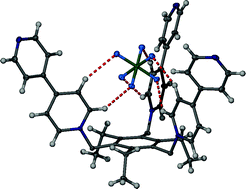Pyridinium CH⋯anion and π-stacking interactions in modular tripodal anion binding hosts: ATP binding and solid-state chiral induction
Abstract
The preparation of two new tripodal ‘pinwheel’ type anion hosts based on a triethylbenzene core and bipyridinium or ethylnicotinium arms is reported. The new materials bind anions via CH⋯anion interactions. Complexes with Br− and PF6− have been characterised by X-ray crystallography as both solvates in a pure form. In the bipyridinium host CH⋯F interactions to PF6− induce a chiral C3 symmetric conformation that is disrupted in the hydrate. The compound is also selective for ATP2− in aqueous acetonitrile.


 Please wait while we load your content...
Please wait while we load your content...